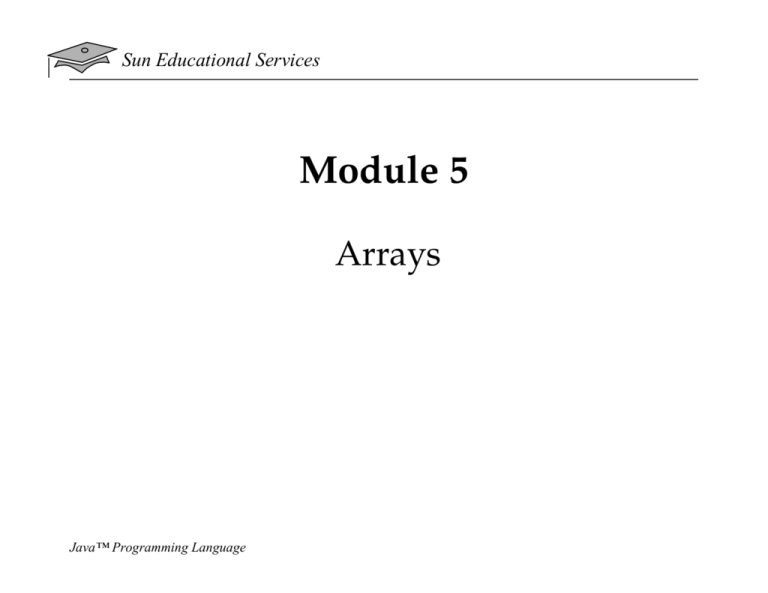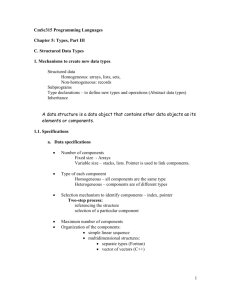
Sun Educational Services
Module 5
Arrays
Java™ Programming Language
Sun Educational Services
Objectives
• Declare and create arrays of primitive, class, or array
types
• Explain why elements of an array are initialized
• Explain how to initialize the elements of an array
• Determine the number of elements in an array
• Create a multidimensional array
• Write code to copy array values from one array type to
another
Java™ Programming Language
Copyright 2002 Sun Microsystems, Inc. All Rights Reserved. Enterprise Services, Revision E.2
Module 5, slide 2 of 15
Sun Educational Services
Relevance
• What is the purpose of an array?
Java™ Programming Language
Copyright 2002 Sun Microsystems, Inc. All Rights Reserved. Enterprise Services, Revision E.2
Module 5, slide 3 of 15
Sun Educational Services
Declaring Arrays
• Group data objects of the same type.
• Declare arrays of primitive or class types:
char s[];
Point p[];
char[] s;
Point[] p;
• Create space for a reference.
• An array is an object; it is created with new.
Java™ Programming Language
Copyright 2002 Sun Microsystems, Inc. All Rights Reserved. Enterprise Services, Revision E.2
Module 5, slide 4 of 15
Sun Educational Services
Creating Arrays
Use the new keyword to create an array object.
For example, a primitive (char) array:
Execution Stack
public char[] createArray() {
char[] s;
Heap Memory
s = new char[26];
for ( int i=0; i<26; i++ ) {
s[i] = (char) (’A’ + i);
}
char[]
A
B
return s;
C
}
D
createArray
s
this
Z
main
Java™ Programming Language
Copyright 2002 Sun Microsystems, Inc. All Rights Reserved. Enterprise Services, Revision E.2
Module 5, slide 5 of 15
Sun Educational Services
Creating Arrays
Another example, an object array:
Execution Stack
public Point[] createArray() {
Point[] p;
Heap Memory
p = new Point[10];
for ( int i=0; i<10; i++ ) {
p[i] = new Point(i, i+1);
}
Point
Point[]
x
y
0
1
return p;
Point
}
x
y
createArray
1
2
p
Point
this
main
Java™ Programming Language
Copyright 2002 Sun Microsystems, Inc. All Rights Reserved. Enterprise Services, Revision E.2
x
y
2
3
Module 5, slide 6 of 15
Sun Educational Services
Initializing Arrays
• Initialize an array element
• Create an array with initial values:
String names[];
names = new String[3];
names[0] = "Georgianna";
names[1] = "Jen";
names[2] = "Simon";
String names[] = {
"Georgianna",
"Jen",
"Simon"
};
MyDate dates[];
dates = new MyDate[3];
dates[0] = new MyDate(22, 7, 1964);
dates[1] = new MyDate(1, 1, 2000);
dates[2] = new MyDate(22, 12, 1964);
MyDate dates[] = {
new MyDate(22, 7, 1964),
new MyDate(1, 1, 2000),
new MyDate(22, 12, 1964)
};
Java™ Programming Language
Copyright 2002 Sun Microsystems, Inc. All Rights Reserved. Enterprise Services, Revision E.2
Module 5, slide 7 of 15
Sun Educational Services
Multidimensional Arrays
• Arrays of arrays:
int twoDim [][] = new int [4][];
twoDim[0] = new int[5];
twoDim[1] = new int[5];
int twoDim [][] = new int [][4]; illegal
Java™ Programming Language
Copyright 2002 Sun Microsystems, Inc. All Rights Reserved. Enterprise Services, Revision E.2
Module 5, slide 8 of 15
Sun Educational Services
Multidimensional Arrays
• Non-rectangular arrays of arrays:
twoDim[0]
twoDim[1]
twoDim[2]
twoDim[3]
=
=
=
=
new
new
new
new
int[2];
int[4];
int[6];
int[8];
• Array of four arrays of five integers each:
int twoDim[][] = new int[4][5];
Java™ Programming Language
Copyright 2002 Sun Microsystems, Inc. All Rights Reserved. Enterprise Services, Revision E.2
Module 5, slide 9 of 15
Sun Educational Services
Array Bounds
All array subscripts begin at 0:
int list[] = new int [10];
for (int i = 0; i < list.length; i++) {
System.out.println(list[i]);
}
Java™ Programming Language
Copyright 2002 Sun Microsystems, Inc. All Rights Reserved. Enterprise Services, Revision E.2
Module 5, slide 10 of 15
Sun Educational Services
Array Resizing
• Cannot resize an array
• Can use the same reference variable to refer to an
entirely new array:
int myArray[] = new int[6];
myArray = new int[10];
Java™ Programming Language
Copyright 2002 Sun Microsystems, Inc. All Rights Reserved. Enterprise Services, Revision E.2
Module 5, slide 11 of 15
Sun Educational Services
Copying Arrays
The System.arraycopy() method:
1
2
3
4
5
6
7
8
9
//original array
int elements[] = { 1, 2, 3, 4, 5, 6 };
// new larger array
int hold[] = { 10, 9, 8, 7, 6, 5, 4, 3, 2, 1 };
// copy all of the elements array to the hold
// array, starting with the 0th index
System.arraycopy(elements, 0, hold, 0, elements.length);
Java™ Programming Language
Copyright 2002 Sun Microsystems, Inc. All Rights Reserved. Enterprise Services, Revision E.2
Module 5, slide 12 of 15
Sun Educational Services
Exercise: Using Arrays
• Exercise objectives:
▼
Implement the concepts presented in this module
• Tasks:
▼
Complete the tasks specified by the instructor
Java™ Programming Language
Copyright 2002 Sun Microsystems, Inc. All Rights Reserved. Enterprise Services, Revision E.2
Module 5, slide 13 of 15
Sun Educational Services
Check Your Progress
• Declare and create arrays of primitive, class, or array
types
• Explain why elements of an array are initialized
• Explain how to initialize the elements of an array
• Determine the number of elements in an array
• Create a multidimensional array
• Write code to copy array values from one array type to
another
Java™ Programming Language
Copyright 2002 Sun Microsystems, Inc. All Rights Reserved. Enterprise Services, Revision E.2
Module 5, slide 14 of 15
Sun Educational Services
Think Beyond
• How can you create a three-dimensional array?
• What is a disadvantage of using arrays?
Java™ Programming Language
Copyright 2002 Sun Microsystems, Inc. All Rights Reserved. Enterprise Services, Revision E.2
Module 5, slide 15 of 15







